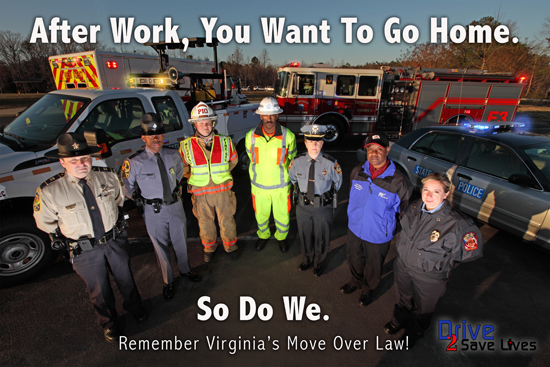"Move Over"
Virginia's Move Over Law Expands July 1, 2023
Highway safety partners,
Virginia's Move Over law is changing effective July 1, 2023.
If you aren't familiar with Move Over, it is a law that currently requires drivers to change lanes and proceed with caution, if possible, when passing emergency vehicles and law enforcement vehicles displaying red or blue flashing lights, and utility, tow, and roadside assistance trucks displaying amber flashing lights on the roadside, according to AAA.
The change, effective July 1, expands this protection to any stationary vehicle displaying hazard lights, warning signs (like an emergency triangle), or flares, AAA said. An example of a situation like this might be a driver who pulls over to the side of the road to fix a flat tire.
We ask for your help to amplify this important message. Join DMV, Virginia State Police, Virginia Department of Transportation, DRIVE SMART Virginia, and AAA in a "thunderclap" by sharing the attached video and the message below on your social media channels at exactly 10 a.m. on Friday, June 30.
Thank you for your continued partnership in making Virginia roads safer for all users!
Social Media Message:
In Virginia, there is a new law effective July 1, 2023!
As an expansion of the current "Move Over" law, drivers must now #MoveOver or #SlowDown when possible for any vehicle on the side of the road with flashing red, blue, amber, or hazard lights.
#MoveOverSlowDownVa
Move Over Weekend – May 6-8, 2022
The Virginia DMV Highway Safety Office will be joining with the National Highway Traffic Safety Administration (NHTSA) in a special Move Over awareness/outreach campaign for the weekend of May 6-8, 2022—which is also Mothers' Day Weekend.
All 50 states have passed laws addressing "Move Over, Slow Down" on our roadways. The Virginia General Assembly passed this law in 2019.
In Virginia between 2018 and 2021, 13 people were injured in 28 crashes as a result of a driver failing to move over for an emergency vehicle(s) responding to a crash with emergency lights activated.
Note: The above move over crash data is identified and compiled based on (1) the "move over" information recorded in the narrative section in the police crash report and/or (2) a driver involved in a crash who was charged with code "46.2-921.1" (vehicle violation/flashing lights) by law enforcement.
Please join us and share the "Move Over, Slow Down" information from the Traffic Safety Marketing site to educate your communities about the importance of protecting your first responders.
 |
In 2014, the Virginia General Assembly enacted legislation designating every June as "Move Over Awareness Month" in Virginia. |
The side of the road is a very dangerous place to be with traffic flying by, but this is exactly where thousands of law enforcement officers, firefighters, rescue personnel, VDOT workers, and other personnel do their jobs every day. Many of these individuals have been injured and killed from being struck by passing vehicles. As a result, the Virginia General Assembly passed legislation in 2002 requiring motorists to move over a lane or slow down to a cautionary speed when approaching stationary vehicles on the road or side of the road that are displaying flashing, blinking or alternating blue, red or amber lights.
In 2014, the month of June was established as "Move Over Awareness Month" in Virginia.
Virginia's "Slow Down/Move Over" Law
Section 46.2-921.1 of the Code of Virginia states:
§ 46.2-921.1. Drivers to yield right-of-way or reduce speed when approaching stationary emergency vehicles on highways; penalties.
A. The driver of any motor vehicle, upon approaching a stationary vehicle that is displaying a flashing, blinking, or alternating blue, red, or amber light or lights as provided in § 46.2-1022, 46.2-1023, or 46.2-1024 or subdivision A 1 or A 2 of § 46.2-1025 shall (i) on a highway having at least four lanes, at least two of which are intended for traffic proceeding as the approaching vehicle, proceed with caution and, if reasonable, with due regard for safety and traffic conditions, yield the right-of-way by making a lane change into a lane not adjacent to the stationary vehicle or (ii) if changing lanes would be unreasonable or unsafe, proceed with due caution and maintain a safe speed for highway conditions.
B. A violation of any provision of this section shall be punishable as a traffic infraction, except that a second or subsequent violation of any provision of this section, when such violation involved a vehicle with flashing, blinking, or alternating blue or red lights, shall be punishable as a Class 1 misdemeanor.
C. If the violation resulted in damage to property of another person, the court may, in addition, order the suspension of the driver's privilege to operate a motor vehicle for not more than one year. If the violation resulted in injury to another person, the court may, in addition to any other penalty imposed, order the suspension of the driver's privilege to operate a motor vehicle for not more than two years. If the violation resulted in the death of another person, the court may, in addition to any other penalty imposed, order the suspension of the driver's privilege to operate a motor vehicle for two years.
D. The provisions of this section shall not apply in highway work zones as defined in § 46.2-878.1.
(2002, cc. 163, 341; 2008, c. 818; 2010, c. 289.)

|



